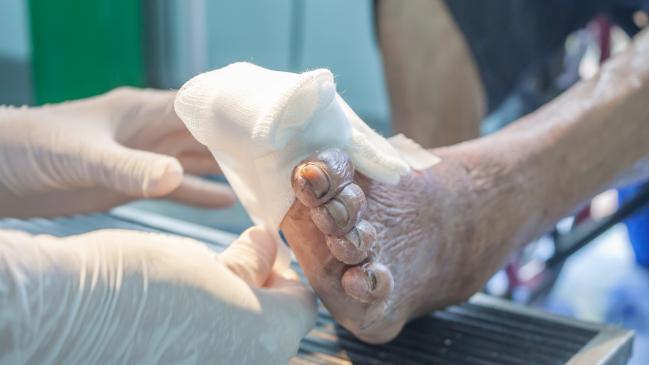Real-World CLTI Patients, Outcomes Are a Departure From BEST-CLI
Medicare patients were more often female and had higher risk of limb events and death with surgery than what was observed in the trial.

PHOENIX, AZ—An analysis of Medicare patients with chronic limb-threatening ischemia (CLTI) paints a divergent picture of real-world patients, the physicians who treat them, and their outcomes compared with what was shown in the BEST-CLI trial, according to a presentation here last weekend at the Society for Cardiovascular Angiography and Interventions (SCAI) 2023 Scientific Sessions.
BEST-CLI was intended to address the optimal strategy for revascularization of CTLI patients in the setting of equipoise. In the trial, patients with suitable anatomy who underwent surgery had fewer major adverse limb events (MALE), major limb interventions, and amputations than those who had endovascular therapy. However, while the trialists said the findings were “level-one evidence” against an endovascular-first approach, criticism of the trial and its methodology was swift. Skeptics pointed to the low enrollment of women and racially diverse patients, and questioned the high rate of technical failure with endovascular therapy that many said did not reflect contemporary practice.
“There were a lot of questions that came out of this trial, especially for us endovascular operators, many of [whom] were not participants,” said Eric A. Secemsky, MD (Beth Israel Deaconess Medical Center, Boston, MA), when presenting the Medicare analysis, which was simultaneously published in JSCAI.
To TCTMD, he explained that the goal of the new analysis “was to get the endovascular community to understand how this trial fits into their practice, where we still don’t have answers, and to start reminding ourselves that there are more than just endovascular treatment options for CLTI.”
There were a lot of questions that came out of this trial, especially for us endovascular operators, many of [whom] were not participants. Eric A. Secemsky
In BEST-CLI, vascular surgeons were responsible for 75% of all the endovascular procedures performed. But in the real-world analysis, Medicare patients were less likely to be treated by surgeons and more likely to be treated by interventional cardiologists.
Additionally, Medicare patients had a higher cumulative incidence of events with surgical revascularization than what was observed in BEST-CLI, regardless of whether autologous or nonautologous grafts were used. While there was no difference in cumulative endovascular events of the primary endpoint—a composite of MALE and death—the frequency of major intervention in the Medicare cohort was less than half that seen in BEST-CLI patients.
According to Secemsky, BEST-CLI is “a critically important trial and there is no question about its value and what it has added to our evidence base for treating patients with CLTI.” That being said, like many large trials, its generalizability to contemporary practice is a clear limitation, he specified.
Outcomes Comparison
For the new analysis, Secemsky and colleagues, led by Neel M. Butala, MD (University of Colorado School of Medicine, Aurora), tried to replicate the study period and characteristics of BEST-CLI within a cohort of 66,153 Medicare beneficiaries aged 65-85 years who underwent a lower limb revascularization and would have met criteria for trial enrollment.
These patients and their outcomes were compared with patients from BEST-CLI cohort 1, who had a single segment of great saphenous vein (SSGSV) for bypass, and cohort 2, who had an alternative bypass conduit, including prosthetic grafts.
The mean age of BEST-CLI cohort 1 patients was 69.9 years, whereas it was 73.2 years in the Medicare patients who had autologous grafts and 73.5 years in those who had endovascular therapy. Nearly 40% of Medicare patients were female compared with just 28.5% of cohort 1 patients and 30% of cohort 2 patients. Medicare patients had higher rates of hypertension, dyslipidemia, and diabetes than the BEST-CLI patients and also were more likely to have CAD (77% vs 43%), congestive heart failure (57% vs 5.6%), a prior stroke (46% vs 13%), or chronic obstructive pulmonary disease (27.7% vs 14.6%).
For endovascular treatment, the risk of MALE or death was 58.7% in the SSGSV-treated Medicare population at 2.7 years versus 57.4% in cohort 1 and 47% in the alternative-conduit Medicare population versus 47.7% in cohort 2 of BEST-CLI.
The incidence of major intervention—defined as new bypass of the index limb, thrombectomy, or thrombolysis—was 10% in the SSGSV-treated Medicare group versus 23.5% in BEST-CLI cohort 1 at 2.7 years, and 8.6% in the alternative-conduit Medicare group vs 25.6% in BEST-CLI cohort 2. Secemsky noted that technical endovascular failures were not captured in this analysis.
In adjusted analyses, the risk of MALE or death at a median 3.1 years was higher with surgery compared with endovascular treatment in Medicare patients (HR 1.05; 95% CI 1.02-1.08), driven primarily by an increased risk of death. This differs from BEST-CLI’s large decrease in risk of MALE or death favoring surgery (HR 0.68; 95% CI 0.59-0.79).
In other adjusted analyses, the amputation rate also was slightly higher among Medicare patients undergoing surgery than endovascular therapy, regardless of whether patients did (adjusted HR 1.11; 95% CI 1.06-1.17) or did not have an autologous graft (adjusted HR 1.24; 95%CI 1.18-1.42).
Potential Implications for Payers
The investigators also looked at the actual sites that enrolled patients into BEST-CLI to understand how many patients were treated at each during the study period, since the question of how many were screened versus how many were enrolled has been an overriding question. Several enrolling centers treated more than 150 Medicare CLTI patients during that window, but enrolled 20 or fewer.
“There was a lot of patients that were being treated in the community that didn't make it into the trial, as to be expected,” Secemsky said. “But this is really important for the community when you're applying a trial result to a population that is varied and with different expertise at each of these centers.”
Following the presentation, session co-moderator Mladen Vidovich, MD (University of Illinois, Chicago), noted that the comparison has implications beyond patients and physicians. “If you're Medicare [or] you're a large insurance carrier and you want to do value-based payments, I think it's really important to have that data,” he said.
If you're Medicare [or] you're a large insurance carrier and you want to do value-based payments, I think it's really important to have that data. Mladen Vidovich
Secemsky agreed that from a Medicare standpoint, all patient costs are critical. The BEST-CLI investigators maintain that patients who are candidates for limb salvage should undergo an evaluation for surgical risk and should have vein mapping to see if they have a good conduit.
“If we're ending up at the same point or even better with endovascular, you have to think about that when you're deciding whether you're going to start shunting all these people to surgical evaluations [and] longer length of stay,” he said. “We know that about 30 to 40% of CLTI patients die at 1 to 2 years.
The findings from the Medicare analysis align with those from the recently published international BASIL-2 trial, which found that CLTI patients were more likely to die or need major amputation when a surgical vein bypass was the primary intervention rather than endovascular therapy.
L.A. McKeown is a Senior Medical Journalist for TCTMD, the Section Editor of CV Team Forum, and Senior Medical…
Read Full BioSources
Butala NM, Chandra V, Beckman JA, et al. Contextualizing the BEST-CLI trial results in clinical practice. JSCAI. 2023;Epub ahead of print.
Disclosures
- Secemsky reports grants to his institution from BD, Boston Scientific, Cook, CSI, Laminate Medical, Medtronic, and Philips; speaking/consulting fees from Abbott, Bayer, BD, Boston Scientific, Cook, Cordis, CSI, Heartflow, Inari, InfraRedx, Medtronic, Philips, RapidAI, Recor, Shockwave and VentureMed.





Comments